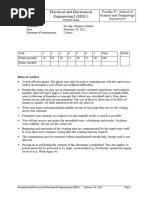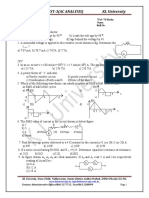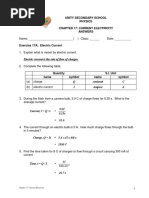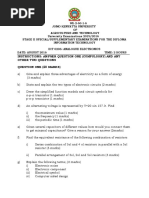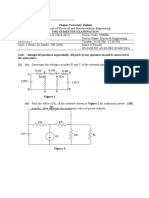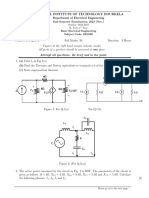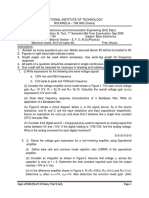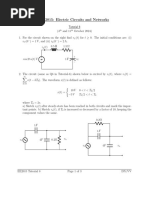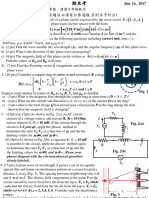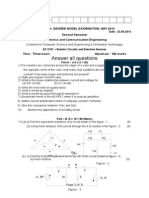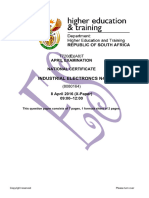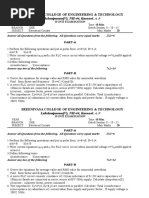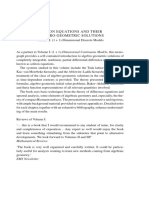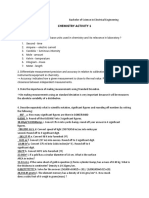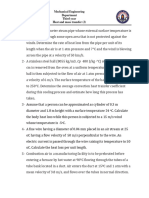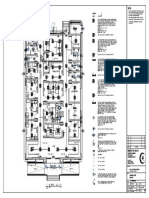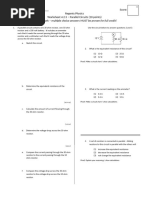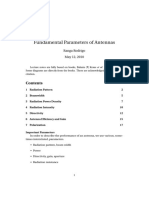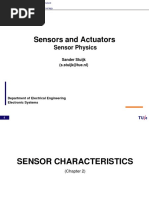Mock Exam EEE1
Mock Exam EEE1
Uploaded by
nareshchand4ualwaysCopyright:
Available Formats
Mock Exam EEE1
Mock Exam EEE1
Uploaded by
nareshchand4ualwaysCopyright
Available Formats
Share this document
Did you find this document useful?
Is this content inappropriate?
Copyright:
Available Formats
Mock Exam EEE1
Mock Exam EEE1
Uploaded by
nareshchand4ualwaysCopyright:
Available Formats
University of Electrical and Electronic Faculty IV: School of
Siegen Engineering 1 Science and Technology
Department ETI
Mock exam
Examiner :
Date :
Duration of examination : 2 hours
Name (readable) :
Matriculation number :
Task 1 2 3 4 5 6 Sum Grade
Points possible 13 10 10 17 30 20 100
Points reached
Rules of conduct
Mock exam: Electrical and Electronic Engineering 1 page 1 of 6
Natural constants
V ⋅s
µ=
0 4π ⋅10−7
A⋅ m
Task 1 (periodic signals) (13 points)
Figure 1 shows one period of the periodically repeating current profile i (t).
The period T is 16ms.
a) What is the mean value i (DC-component) of the current? (4 points)
b) What is the effective value (r.m.s.) of the current? (6 points)
c) Plot the AC-component i~(t) of the current in figure 1. (3 points)
i A
5
4
3
2
1
ms
0
T
0 1 2 3 4 5 6 7 8 9 10 11 12 13 14 15 16
-1 t
-2
-3
-4
Figure 1: One period of the periodic current
Mock exam: Electrical and Electronic Engineering 1 page 2 of 6
Task 2 (Inductance) (10 points)
Figure 2 shows the current through an inductance L = 30 mH.
Calculate the time-dependent voltage across the inductance for each time segment.
Scale the right axis and plot the time-dependent voltage in figure 2.
Note: The current is linear in sections.
Ai
100 u
90
80
70
60
50
40
30
20
10
t
0
ms
-10 0 1 2 3 4 5 6 7 8
-20
-30
-40
-50
-60
-70
-80
-90
-100
Figure 2: Current through an inductor
Task 3 (Three phase AC system) (10 points)
Two single-phase ohmic-inductive loads are connected to a three-phase power system with a
line-to-line voltage of U = 400 V, see figure below.
Load 1: absorbed real power P1 = 1500 W, power factor cos φ1 = 0,86
Load 2: absorbed real power P2 = 1200 W, power factor cos φ2 = 0,78
Calculate the line currents I1, I2, I3 (rms-values).
Mock exam: Electrical and Electronic Engineering 1 page 3 of 6
Task 4 (Linear DC circuit) (17 points)
Consider the linear DC network with voltage U0 and resistances Ri and RA to RG according to
figure 3.
URi UA
IA
R i= RA=
5Ω RB= UB 3Ω RD= UD RF= UF
I0 15Ω 10Ω 20Ω
IB ID IF
U0=
240V
RC= UC RE= UE RG= UG
10Ω 5Ω 5Ω
IC IE
IG
Figure 3: Linear DC circuit
a) Calculate the currents I0, IA und ID. (11 points)
b) Calculate the voltages URi, UA, UD and UE. (4 points)
c) Check the plausibility of the results of subtask b) by applying Kirchhoff’s voltage
law. (2 points)
Mock exam: Electrical and Electronic Engineering 1 page 4 of 6
Task 5 (AC circuit) (30 points)
A voltage source UQ with the frequency f and an ohmic internal resistance RF supplies an ohmic-
inductive consumer V, which has the complex impedance ZV.
With the switch S, a capacitor C with the complex impedance ZC can be switched in parallel with
the consumer V.
Numerical values:
UQ = 230 V, RF = 0,2 Ω, ZV = (3+j4) Ω, C = 400 µF, f = 50 Hz
a) First task: switch S is open (index o)
a1) Determine the complex consumer current IFo in Cartesian and in exponential form.
(6 points)
a2) Determine the power loss PFo of the internal resistance RF. (3 points)
b) Second task: switch S is closed (index c)
b1) Determine the complex impedance ZC of the capacitor. (2 points)
b2) Determine the complex impedance of the parallel connection of capacitor and
consumer. (6 points)
b3) Determine the complex current IFc through the internal resistance RF.
(5 points)
b4) Determine the power loss PFc of the internal resistance RF. (3 points)
b5) To what percentage (%) of the original losses PFo could the losses be reduced by
connecting the capacitor in parallel (PFc)? (2 points)
b6) What active power is supplied by the voltage source to the circuit? (3 points)
Mock exam: Electrical and Electronic Engineering 1 page 5 of 6
Task 6 (Magnetic circuit) (20 points)
The magnetic circuit shown below is equipped with a coil with N turns through which a current I
flows.
Determine the following quantities:
a) the magnetic resistance of the magnetic circuit (10 points)
b) the inductance (2 points)
c) the magnetic flux (3 points)
d) the magnetic flux density (2 points)
e) the force, that is exerted on the surfaces of the air gap C (3 points)
A = 100mm
B = 60mm
T = 20mm
C = 4mm
N = 1000 Number of turns of the coil
µr = 5000
I = 5 A : current through coil
A B C
T
A
magnetic circuit
Mock exam: Electrical and Electronic Engineering 1 page 6 of 6
You might also like
- Ee460 Major 2 071 KassasDocument4 pagesEe460 Major 2 071 KassasTurki AlsalehNo ratings yet
- Astm - F330Document5 pagesAstm - F330Mehdi GouaderNo ratings yet
- EEE1 2022 02 10 Online ExamPaperDocument7 pagesEEE1 2022 02 10 Online ExamPaperMARIAMOO1No ratings yet
- EEE1 2021 04 24 Online ExamPaperDocument6 pagesEEE1 2021 04 24 Online ExamPaperSindy CondoNo ratings yet
- EST130 BASICS OF ELECTRICAL AND ELECTRONICS ENGINEERING, DECEMBER 2021Document3 pagesEST130 BASICS OF ELECTRICAL AND ELECTRONICS ENGINEERING, DECEMBER 2021fidropodruNo ratings yet
- Electrical Circuit Analysis - II 2 Question PapersDocument8 pagesElectrical Circuit Analysis - II 2 Question Paperssrinu247100% (1)
- Networks Test-3 (Ac Analysis) KL UniversityDocument10 pagesNetworks Test-3 (Ac Analysis) KL UniversitySURESH KUMAR PITTALANo ratings yet
- Roll No. - B.E / B.Tech (Full Time) Degree End Semester Examinations, April / May 2014Document3 pagesRoll No. - B.E / B.Tech (Full Time) Degree End Semester Examinations, April / May 2014Satheesh Kumar GanesanNo ratings yet
- 15A02301 Electrical Circuits - IIDocument2 pages15A02301 Electrical Circuits - IIsuresh270No ratings yet
- Exercises EE 2023 11 08Document11 pagesExercises EE 2023 11 08MARIAMOO1No ratings yet
- CHP 17 PP Current Electricity W SansDocument7 pagesCHP 17 PP Current Electricity W SansFrancis Ho HoNo ratings yet
- bt21R0718 p1 18 11 09rahulDocument30 pagesbt21R0718 p1 18 11 09rahulAnonymous nTxB1EPvNo ratings yet
- Elec209 1705355554569Document6 pagesElec209 1705355554569family7482pleaseNo ratings yet
- E2101ADocument14 pagesE2101AnotwynnkohNo ratings yet
- Consider An Ideal Voltage Source Described by The Function V (T) 5 Sin T V. The Value of ThisDocument9 pagesConsider An Ideal Voltage Source Described by The Function V (T) 5 Sin T V. The Value of ThisZeshan SubairNo ratings yet
- Tutorial 3Document6 pagesTutorial 3SYAFIQAH ISMAILNo ratings yet
- FPELC02 - Semester Test 1 (2020)Document7 pagesFPELC02 - Semester Test 1 (2020)Previn BogopaNo ratings yet
- Dkk1352-Electrical Technology 21213Document7 pagesDkk1352-Electrical Technology 21213Kalterz UnionNo ratings yet
- Dit 0206 Analogue ElectronicsDocument5 pagesDit 0206 Analogue ElectronicspatrickNo ratings yet
- On-Line Mid Term Examination Semester Ii SESSION 2019/2020: LecturerDocument4 pagesOn-Line Mid Term Examination Semester Ii SESSION 2019/2020: Lecturernor asyiqinNo ratings yet
- Electricity Questions and SolutionsDocument41 pagesElectricity Questions and SolutionsDaveyNo ratings yet
- CAT2Document24 pagesCAT2SANJUCTA CHOUDHURYNo ratings yet
- XII - Physics - Frequently Asked Question BankDocument200 pagesXII - Physics - Frequently Asked Question BankPiyush SuryawanshiNo ratings yet
- 1PUC Electronics Question Papers 2013Document8 pages1PUC Electronics Question Papers 2013Prasad C M100% (3)
- Electrical Circuit Analysis II 2 QuestioDocument8 pagesElectrical Circuit Analysis II 2 Questioc.madhumanoNo ratings yet
- EST QuestionDocument3 pagesEST QuestionashNo ratings yet
- Power Electronics Summative 202 SaturdayDocument3 pagesPower Electronics Summative 202 SaturdayTấn Long Đoàn NguyễnNo ratings yet
- EE1000Document2 pagesEE1000ilovejeevan64No ratings yet
- EPCE2101 Final Exam ANS (2)Document10 pagesEPCE2101 Final Exam ANS (2)yididyashimelisNo ratings yet
- NET201 Network Theory Set-A AS2018Document6 pagesNET201 Network Theory Set-A AS2018SofelNo ratings yet
- BEE Q.Paper 2020-21Document2 pagesBEE Q.Paper 2020-21sarwath sultanaNo ratings yet
- PDF 4Document4 pagesPDF 4r.eg.i.nea.rku.anoNo ratings yet
- BE 1st Midterm Sep2009Document3 pagesBE 1st Midterm Sep2009YASHNo ratings yet
- Course: Introduction To Electric Energy (Ece 351)Document4 pagesCourse: Introduction To Electric Energy (Ece 351)Anonymous Wxihx6No ratings yet
- Answers Quiz # 31_(Alternating_current)Document8 pagesAnswers Quiz # 31_(Alternating_current)Sandeep MishraNo ratings yet
- 19A02401T Electrical Circuit AnalysisDocument2 pages19A02401T Electrical Circuit Analysisfepov48405No ratings yet
- E2001 Circuit Analysis: Academic Year 2020-2021Document15 pagesE2001 Circuit Analysis: Academic Year 2020-2021Eunice GohNo ratings yet
- SPH 3152 Electricity and Magnetism IDocument4 pagesSPH 3152 Electricity and Magnetism Ijillen imbugaNo ratings yet
- Topic 3 Tutorial Direct Current CircuitsDocument6 pagesTopic 3 Tutorial Direct Current Circuitsm-320302No ratings yet
- Pe 2Document4 pagesPe 2Vaibhav YadavNo ratings yet
- Jntuk 2 1 Eca II Nov 2017 Q.PDocument8 pagesJntuk 2 1 Eca II Nov 2017 Q.PSd KhadarNo ratings yet
- MR8497 PDFDocument8 pagesMR8497 PDFsaipavan999No ratings yet
- EE1000Document2 pagesEE1000Swastik LenkaNo ratings yet
- Basic Electrical Engineering: Instructions To CandidatesDocument3 pagesBasic Electrical Engineering: Instructions To CandidatesAmrinderNo ratings yet
- PT 1Document5 pagesPT 1Karthik BolluNo ratings yet
- Tutorial 8Document3 pagesTutorial 8Shriram A ep23b019No ratings yet
- II B.Tech II Semester, Regular Examinations, April - 2012 Electrical Circuit Analysis - IiDocument8 pagesII B.Tech II Semester, Regular Examinations, April - 2012 Electrical Circuit Analysis - IiViswa ChaitanyaNo ratings yet
- ESE_BEE_Sem1_21-22_Set ADocument4 pagesESE_BEE_Sem1_21-22_Set Asandeep.menon24No ratings yet
- Final 2017-SpringDocument10 pagesFinal 2017-Springyulin linNo ratings yet
- Full Marks: 50 Duration: 3 HoursDocument2 pagesFull Marks: 50 Duration: 3 HoursK JaiswalNo ratings yet
- WWW - Manaresults.Co - In: Network AnalysisDocument12 pagesWWW - Manaresults.Co - In: Network AnalysisAnith Kumar ReddyNo ratings yet
- Cap2 Eletronica de PotenciaDocument5 pagesCap2 Eletronica de PotenciaSjf Net0% (1)
- 5 EC 2151 - Electric Circuits and Electronic DevicesDocument3 pages5 EC 2151 - Electric Circuits and Electronic DevicesBIBIN CHIDAMBARANATHANNo ratings yet
- Power Electronics Questions AnswersDocument59 pagesPower Electronics Questions AnswersPascal UZABAKIRIHONo ratings yet
- Circuits 2Document6 pagesCircuits 2hhtg210No ratings yet
- N4 Industrial Electronics April 2016Document9 pagesN4 Industrial Electronics April 2016advice nethengweNo ratings yet
- Madhav Electrical CircuitsDocument2 pagesMadhav Electrical CircuitsKVSRIT Dept. of MENo ratings yet
- Applied Elec 2Document3 pagesApplied Elec 2Kyeremeh EmmanuelNo ratings yet
- 2021 22 Even 1Document28 pages2021 22 Even 1sarojkuldeepkumar181No ratings yet
- Expt-2 Network TheoremsDocument20 pagesExpt-2 Network TheoremsADITYA ASHUTOSHNo ratings yet
- Exercises in Electronics: Operational Amplifier CircuitsFrom EverandExercises in Electronics: Operational Amplifier CircuitsRating: 3 out of 5 stars3/5 (1)
- WPQT ReceivingDocument3 pagesWPQT Receivingphilweld navotasNo ratings yet
- B 807394 BDDocument7 pagesB 807394 BDVikas KumarNo ratings yet
- Mathematical Model of Systems:: Rotational Mechanical System Transfer FunctionDocument13 pagesMathematical Model of Systems:: Rotational Mechanical System Transfer Functionchardo santosNo ratings yet
- Abb ZX2 - enDocument16 pagesAbb ZX2 - enHana Ben JaballahNo ratings yet
- Soliton Equations and Their Algebro-Geometric SolutionsDocument448 pagesSoliton Equations and Their Algebro-Geometric Solutionsmohamed ragabNo ratings yet
- Forced Vibration of SD F SystemDocument7 pagesForced Vibration of SD F SystemJagadish KNo ratings yet
- Basics of EEG Signals 1697602876Document1 pageBasics of EEG Signals 1697602876Hanin AlSiniNo ratings yet
- PowerSystem Set1Document9 pagesPowerSystem Set1shivansh gandhiNo ratings yet
- 2014 Hireko Quick Shaft Fitting GuideDocument7 pages2014 Hireko Quick Shaft Fitting GuideParker GatesNo ratings yet
- KU 13 AntennaDocument30 pagesKU 13 Antennawexeta3713No ratings yet
- Monolithic Voltage-Controlled Oscillators: General Description FeaturesDocument6 pagesMonolithic Voltage-Controlled Oscillators: General Description FeaturesGerard PabloNo ratings yet
- 2 The Universe Scientific Laws and TheoriesDocument66 pages2 The Universe Scientific Laws and Theorieshi mynameNo ratings yet
- 24 Metallic Spintronics, Dr. M. TsoiDocument27 pages24 Metallic Spintronics, Dr. M. TsoiSam AkinaNo ratings yet
- Chapter 2. Hydraulic PumpsDocument44 pagesChapter 2. Hydraulic PumpsrasolisrNo ratings yet
- Chemistry Activity1Document2 pagesChemistry Activity1Vincent CASTRONo ratings yet
- Sheet 2 + SolDocument11 pagesSheet 2 + SolIAM ENGINEERNo ratings yet
- El-02 Lighting LayoutDocument1 pageEl-02 Lighting LayoutAbdulaziz Al-FarsiNo ratings yet
- AXIS Catalogue 2018Document49 pagesAXIS Catalogue 2018Tran Quoc Thinh - M&ENo ratings yet
- United States Patent: Steigerwalt Et Al. (10) Patent No.: US 7.562.454 B2Document25 pagesUnited States Patent: Steigerwalt Et Al. (10) Patent No.: US 7.562.454 B2Слэйтер Строительная компанияNo ratings yet
- Liycy Cable 1Document3 pagesLiycy Cable 1Andres RuedaNo ratings yet
- 4-2-5 Worksheet - Parallel CircuitsDocument1 page4-2-5 Worksheet - Parallel Circuitsbaotran18122005No ratings yet
- Steam Jet Air EjectorsDocument3 pagesSteam Jet Air EjectorsSherwin SabandoNo ratings yet
- Antenna ParametersDocument19 pagesAntenna ParametersSHANTANU B SNo ratings yet
- Sensors and Actuators: Sensor PhysicsDocument40 pagesSensors and Actuators: Sensor PhysicsNguyễn Văn ĐiệpNo ratings yet
- Fundamentals of Power System Protection: Enrolment Code: 285796413Document40 pagesFundamentals of Power System Protection: Enrolment Code: 285796413Syed KhizarNo ratings yet
- Shrinkage-Swelling Potential of SoilDocument70 pagesShrinkage-Swelling Potential of SoilNoraima EdrisNo ratings yet
- Class 9 Science → Chapter Notes – Sound - DronStudyDocument10 pagesClass 9 Science → Chapter Notes – Sound - DronStudythetajinstituteNo ratings yet
- Vector Mechanics For Engineers: Dynamics: Twelfth EditionDocument47 pagesVector Mechanics For Engineers: Dynamics: Twelfth EditionFady MagedNo ratings yet
- 12 Math CH-7 Exercise 7.1Document10 pages12 Math CH-7 Exercise 7.1John EliaNo ratings yet


